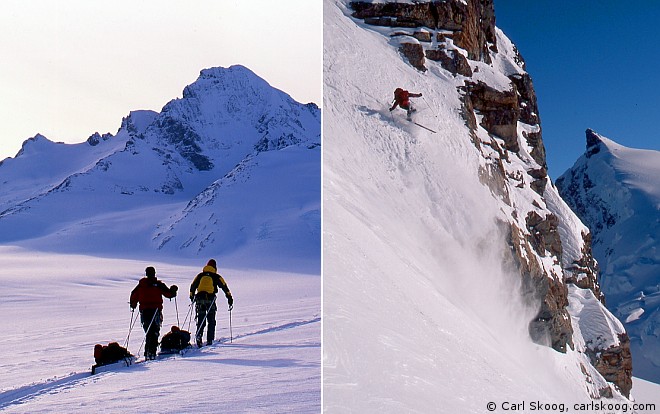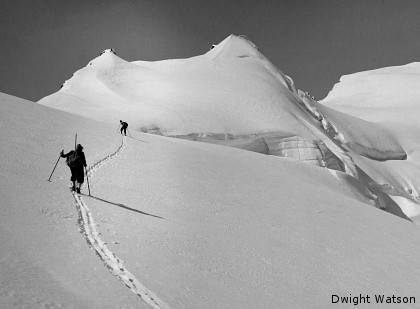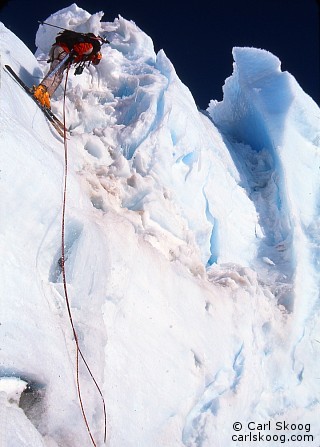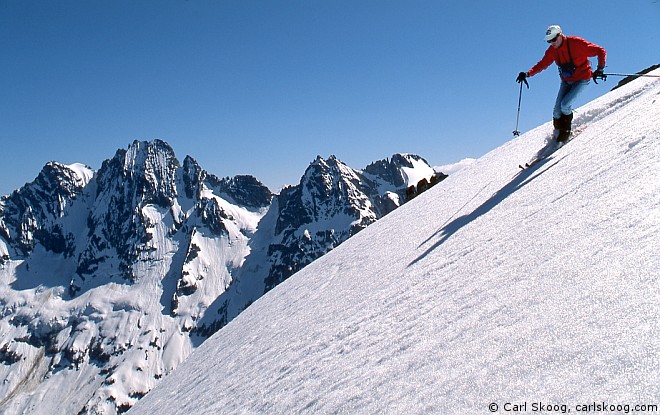

|
|
I wrote this essay for the book, Backcountry Skiing: Skills for
Ski Touring and Ski Mountaineering, by Martin Volken, Scott Schell,
and Margaret Wheeler, published by The Mountaineers Books in 2007. In
2025, I updated the text here to replace the word "randonnee" with the
more recently preferred term, "skimo."
--Lowell Skoog
Arnold Lunn wrote in the early 1900s, "Ski mountaineering is the result of the marriage of two great sports, mountaineering and skiing." But is it mostly mountaineering, or mostly skiing? Are skis tools to achieve some end, or is skiing itself the end? The ski mountaineer crossing a glacier on a high-level traverse and the extreme skier linking turns on a must-not-fall descent have answered these questions very differently.
Marcel Kurz, who pioneered the Chamonix-to-Zermatt Haute Route in 1911, wrote, "In the high mountains the ski ceases to be a plaything. Circumstances make it a tool--the most useful aid to the winter mountaineer--but a simple tool intended to make traveling easier--something which we put on or take off like crampons and which is only a means to an end." Kurz's viewpoint was typical of the early 1900s. The pioneers of ski mountaineering used skis for winter ascents and high-level traverses. They wanted to go places in the mountains, and skis were tools for the job. The pioneering era of ski mountaineering ended around the time of World War II, when mechanical lifts became common in Europe and North America. Skis, for the vast majority of skiers who rode lifts, were simply playthings. Just a tiny minority of skiers continued to do mountaineering. For three decades, they were largely content to repeat the accomplishments of the pre-war pioneers. Arnold Lunn, the Englishman who did so much to promote ski mountaineering before the war, invented modern slalom racing in the 1920s. He did it, he later wrote, "inspired by the naive concern that downhill racing would help to develop the kind of technique suitable for ski mountaineering." (Slalom was supposed to simulate "tree-running" during the descent from a peak.) By the 1960s, Lunn lamented that ski racers had become "a bunch of ballet dancers on skis" and that the sport was infected by "downhill-only disease." He recalled, "In the remote past, skis were the passport to untracked snow and unexplored slopes." That was no longer true, it seemed.
Ironically, slalom racing and other developments from lift skiing began to profoundly influence ski mountaineering soon after Lunn's death in 1974. In North America, former lift skiers fleeing the crowds and constraints of ski resorts rediscovered Nordic touring and the telemark turn. Although it was not as suitable for downhill skiing as the alpine gear of the day, lightweight Nordic gear was much more mobile and it became the preferred tool for North American skiers to leave the beaten path. Telemark skiers sparked a renaissance in backcountry skiing in the 1970s and 1980s, pioneering high-level ski routes in North America's wilderness mountains similar to those done earlier in the more civilized Alps. They had rediscovered the ski as a tool for mountaineering. In Europe, a small number of ski instructors and mountain guides began using alpine skis to descend steep climbing routes, where a fall would likely spell death. Such feats would not have been possible without the advances in equipment and technique driven by ski racing. By the late 1970s, competition for first ski descents in the French Alps grew so intense that ethical disputes arose over the use of helicopters for the ascent and rappels for the descent. Skis, for these mountaineers, were a far cry from Marcel Kurz's "tools to make traveling easier." They were playthings, employed in an elaborate and deadly serious game. Since the 1990s, Nordic and alpine touring have converged. Nordic equipment has become more downhill-capable and alpine equipment has become more touring-friendly. The new balance is illustrated by randonnee racing (more recently called skimo), a European invention that has recently taken hold in North America. Racing up, down, and across the mountains, this sport is something that Arnold Lunn would certainly have recognized. Skimo racing is likely to spawn new developments that will make it easier for tomorrow's ski mountaineers to return to the roots of the sport--exploring the mountains.
|
The Alpenglow Gallery


